Croats of Serbia
Croats are a recognized national minority in Serbia, a status they received in 2002.[2] The majority of the Bunjevac and Šokac communities traditionally identify as part of the Croatian minority as well.[3] Croats are the fourth largest ethnic group in the Vojvodina province, an autonomous province located in the northern part of the country which traditionally fosters multilingualism, multiculturalism and multiconfessionalism.[4]
Hrvati u Srbiji Хрвати у Србији | |
|---|---|
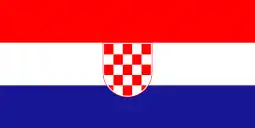 Flag of Croats of Serbia adopted by the Croat National Council | |
| Total population | |
| 39,107 (2022)[1] | |
| Regions with significant populations | |
| 32,684 (2022)[1] | |
| 4,554 (2022)[1] | |
| Languages | |
| Croatian, Serbian (both standardized varieties of Serbo-Croatian), and Bunjevac dialect | |
| Religion | |
| Catholicism | |
| Related ethnic groups | |
| Bunjevci, Šokci, Croat diaspora | |
| Part of a series on |
| Croats |
|---|
 |
History
During the 15th century, Croats mostly lived in the Syrmia region. It is estimated that they were a majority in 76 out of 801 villages that existed in the present-day territory of Vojvodina.[5]
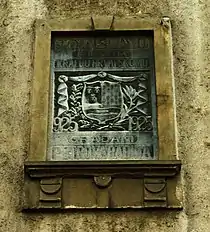
According to 1851 data, it is estimated that the population of the Voivodeship of Serbia and Banat of Temeschwar, the historical province that was predecessor of present-day Vojvodina, included, among other ethnic groups, 62,936 Bunjevci and Šokci and 2,860 Croats.[6] Subsequent statistical estimations from the second half of the 19th century (conducted during Austro-Hungarian period) counted Bunjevci and Šokci as "others" and presented them separately from Croats (in 1910 Austro-Hungarian census, 70,000 Bunjevci were categorized as "others").[7]
The 1910 Austro-Hungarian census also showed large differences in the numbers of those who considered themselves Bunjevci and Šokci, and those who considered themselves Croats. According to the census, in the city of Subotica there were only 39 citizens who declared Croatian as their native language, while 33,390 citizens were listed as speakers of "other languages" (most of them declared Bunjevac as their native language).[8] In the city of Sombor, 83 citizens declared Croatian language, while 6,289 citizens were listed as speakers of "other languages" (mostly Bunjevac).[8] In the municipality of Apatin, 44 citizens declared Croatian and 7,191 declared "other languages" (mostly Bunjevac, Šokac and Gypsy).[8]
In Syrmia, which was then part of the Kingdom of Croatia-Slavonia, according to the 1910 census results[9] Croats were a relative or absolute majority in Gibarac (843 Croats or 86.46% out of total population), Kukujevci (1,775 or 77.61%), Novi Slankamen (2,450 or 59.22%), Petrovaradin (3,266 or 57.02%), Stari Slankamen (466 or 48.19%), Hrtkovci (1,144 or 45.43% ) and Morović (966 or 41.67%). Other places which had a significant minority of Croats included Novi Banovci (37.70%), Golubinci (36.86%), Sremska Kamenica (36.41%), Sot (33.01%), Sremska Mitrovica (30.32%), Sremski Karlovci (29.94%) and Ljuba (29.86%).

In 1925, Bunjevac-Šokac Party and Pučka kasina organized in Subotica the 1000th-anniversary celebration of the establishment of Kingdom of Croatia, when in 925 Tomislav of Croatia became first king of the Croatian Kingdom. On the King Tomislav Square in Subotica a memorial plaque was unveiled with the inscription "The memorial plaque of millennium of Croatian Kingdom 925-1925. Set by Bunjevci Croats".[10] Besides Subotica, memorial plaques of King Tomislav were also revealed in Sremski Karlovci and Petrovaradin.
In 1990s, during the war in Croatia was persecution of Croats in Serbia during Yugoslav Wars, members of Serbian Radical Party organized and participated in the expulsion of the Croats in some places in Vojvodina.[11][12][13] The President of the Serbian Radical Party, Vojislav Šešelj is indicted for participation in these events.[14] According to some estimations, the number of Croats which have left Serbia under political pressure of the Milošević's regime might be between 20,000 and 40,000.[15]
In 2020 the birth home of ban Josip Jelačić built in the 18th century and located in Petrovaradin, was bought by the Republic of Serbia from private owners. It was later reconstructed and given as a gift to the Croatian community.[16]

Coat of arms
Flag and coat of arms of Croats of Serbia were adopted on 11 June 2005 in a session of the Croat National Council, in Subotica.
Politics
The Croat National Council is a body of self-government of the Croatian minority in Serbia.[17] On 11 June 2005 the Council adopted the historical coat of arms of Croatia, a checkerboard consisting of 13 red and 12 white fields (the difference with the Croatian coat of arms being the crown on top).
Demographics
In the results of census taking is a disagreement between real ethnicity and declared ethnicity.[18] Most citizens who declare that they belong to a specific ethnic/minority group, already come from families with mixed family backgrounds (e.g. mixed marriages between different nationalities/ethnicities, interreligious marriages). The Republic of Serbia is using a "segregated model of multiculturalism".[19] The national councils receive funds from the state and province to finance their own governing body, cultural, and educational organisations.[20] The amount of money for the national councils, depends on the results of a census in which the Serbian population can register and self-declare as a member of a state-recognized minority of their choice.[21][22]
Today, most members of the Šokci community consider themselves Croats. The Bunjevci in the Hungarian and Serbian Bačka area, are split between those who declare themselves as a distinct ethnic group with their own language and those who identify themselves as a Croatian sub-ethnic group.[23] The latter are represented in Serbia by the Croat National Council,[24][25] and the former by the Bunjevac National Council.[26][27] Not all Croats in Serbia have Bunjevac or Sokac origins.
In the 1990s, during the Milošević regime (1989–1997), it was life-threatening in Serbia to declare to be a Bunjevac Croat: "... to declare themselves as Bunjevac in order to avoid being stigmatised as Croats, thus increasing the number of self-declared Bunjevci in the 1990s."[28]
The number of Croats in Serbia was somewhat larger in previous censuses that were conducted between 1948 and 1991. Proponents of a separate Bunjevac nation argue that the number of Croats may have been smaller at that time, as the communist authorities counted in the people to as Croats, who self-declared as Bunjevac or Sokac. Robert Skenderović emphasizes that already before 1918 and the Communist rule, Bunjevci have made strong efforts to be recognized as part of the Croatian people.[29]
The largest recorded number of Croats in a census was in 1961 when there were 196,409 Croats (including Bunjevci and Šokci) in the Socialist Republic of Serbia (around 2.57% of the total population of Serbia at the time). Since 1961 census, the Croat population in Serbia is in a constant decrease. This is caused by various reasons, including economic emigration, and ethnic tensions of the Yugoslav wars during the 1990s, more specifically the 1991-1995 War in Croatia.[30] During this war-time period, Croats in Serbia were under pressure from the Serbian Radical Party[31][32] and some Serb refugees from Croatia and Bosnia and Herzegovina to move to Croatia. In that time, a transfer of population occurred between Croats from Serbia and Serbs from Croatia.[33][34] Based on an investigation by the Humanitarian Law Fund from Belgrade in the course of June, July, and August 1992, more than 10,000 Croats from Vojvodina exchanged their property for the property of Serbs from Croatia, and altogether about 20,000 Croats left Serbia.[35] According to other estimations, the number of Croats who have left Serbia under political pressure of the Milošević's regime might be between 20,000 and 40,000.[15] According to Petar Kuntić of Democratic Alliance of Croats in Vojvodina, 50,000 Croats were pressured to move out from Serbia during the Yugoslav wars.[36][37]
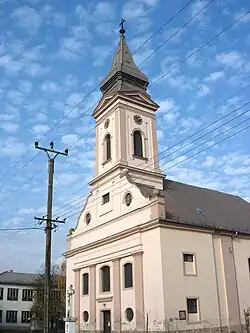
| Year (census data) |
Number of ethnic Croats | Percent of national population |
|---|---|---|
| 1948 | 169,894[38] | 2.6% |
| 1953 | 162,158[38] | 2.3% |
| 1961 | 196,411[38] | 2.6% |
| 1971 | 184,913[38] | 2.2% |
| 1981 | 149,368[38] | 1.6% |
| 1991 | 105,406[38] | 1.1% |
| 1991* | 97,344 | 1.2% |
| 2002* | 70,602[39] | 0.9% |
| 2011* | 57,900[40] | 0.8% |
| 2022* | 39,107[41] | 0.6% |
* - excluding Kosovo
.png.webp)
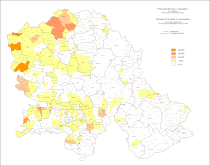
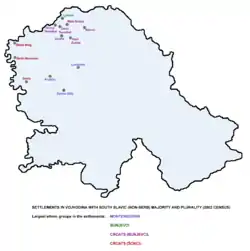
In the 2022 census of the Republic of Serbia: 39,107 Croats and 11,104 Bunjevci are registered, of which the census methodology has not made a subdivision of percentage respondents identifying themselves as Bunjevac Croats or as a separate Bunjevac ethnicity, in conjunction with their belief of being a distinct Bunjevac people.[42] According to the 2011 census, there were 57,900 Croats in Serbia or 0.8% of the country's population.[43] Of these, 47,033 lived in Vojvodina,[44] where they formed the fourth largest ethnic group, representing 2.8% of the population. A further 7,752 lived in the national capital Belgrade, with the remaining 3,115 in the rest of the country.
Croats of Šokac origin constituting the largest part of population in three villages: Sonta (in the municipality of Apatin), Bački Breg and Bački Monoštor (both in the municipality of Sombor).[45] And Croats of Bunjevac origin are living traditionally in Subotica, which is their cultural and political center; in Bajmok, Bikovo, Donji Tavankut and Gornji Tavankut, Đurđin, Ljutovo, Mala Bosna, Sombor, and Stari Žednik.
| Year (census data) |
Number of ethnic Croats | Percent of national population |
|---|---|---|
| 1495 | 7,500 | 3.9% |
| 1787 | 38,161 | 8.0% |
| 1828 | 67,692 | 7.8% |
| 1840 | 66,362 | 7.3% |
| 1857 | 60,690 | 5.9% |
| 1880 | 72,298 | 6.1% |
| 1890 | 80,404 | 6.0% |
| 1900 | 81,198 | 5.7% |
| 1910 | 91,366 | 6.0% |
| 1921 | 129,788 | 8.5% |
| 1931 | 132,517 | 8.2% |
| 1940 | 101,035 | 6.1% |
| 1948 | 134,232 | 8.1% |
| 1953 | 128,054 | 7.5% |
| 1961 | 145,341 | 7.8% |
| 1971 | 138,561 | 7.1% |
| 1981 | 109,203 | 5.4% |
| 1991 | 74,226 | 3.7% |
| 2002 | 56,546 | 2.7% |
| 2011 | 47,033 | 2.4% |
source:[46]
note1: The numbers were adjusted for the present borders of Vojvodina.
note2: Croats are counted together with Bunjevci and Šokci for data before 1991.
Language
Croatian, a standard variety of the pluricentric language Serbo-Croatian, is listed, since 2002, as one of the six official languages of Vojvodina.
The European Union has an active policy to promote the use of regional or minority languages in Serbia.[47]
Bunjevac dialect
Some members of the Bunjevac community, preserved a Neo-Shtokavian–Younger Ikavian dialect of the Serbo-Croatian pluricentric language, also known as Bunjevac dialect (bunjevački dijalekt) or Bunjevac speech (bunjevački govor).[48] Their accent is purely Ikavian, with /i/ for the Common Slavic vowels yat.[49] Since 2021, Croatia has categorized the Neo-Stokavian Younger Ikavian dialect to be the Bunjevac dialect with three sub-branches: Danubian (also known as Bunjevac), Littoral-Lika, and Dalmatian (also known as Bosnian–Dalmatian).[50] Its speakers largely use the Latin alphabet and are living in parts of Bosnia and Herzegovina, parts of Croatia, southern parts (inc. Budapest) of Hungary as well in parts of the autonomous province Vojvodina of Serbia.
There have been three meritorious people who preserved the Bunjevac dialect in two separate dictionaries: Grgo Bačlija[51] and Marko Peić[52] with "Ričnik bački Bunjevaca"[53] (editions 1990, 2018), and Ante Sekulić[54] with "Rječnik govora bačkih Hrvata" (2005).
For decades, there has been an unresolved language battle within the Bunjevac community and between Serbia and Croatia over the status of the Bunjevac speech.[55][56][57]
The dialect, of the in Serbia residating Danubian Bunjevci, was standardised in the Republic of Serbia in 2018 and officially approved as a standard dialect by the Ministry of Education for teaching in schools.[58][59][60][61] With the standardisation of the Bunjevac dialect, activists and members of the Bunjevac National Council are striving for language secession, with the political aim that the Bunjevac dialect will gain in Serbia the political-linguistic status of independent language. Theodora Vuković has provided, in 2009, the scientific methodology for the finalization of the standardisation process of the Bunjevac dialect corpus in Serbia,[62][63] classified as the Serbian Bunjevac dialect variety of the Danubian branch of the Neo-Shtokavian Younger Ikavian dialect. Speakers use in general the standardised dialect variety for writing and conversation in formal situations.[64]
On March 4, 2021, the municipal council in Subotica has voted in favor of amending the city statute, adding Bunjevac dialect to the list of official public administrative languages in the municipality, in addition to Serbian, Hungarian, and Croatian.[65] This has created a special situation that contradicts the official position, of both the Government of Serbia and Matica srpska, that classified Bunjevac speech as a dialect.[66]
Popularly, the Bunjevac dialect is often referred to as "Bunjevac language" (bunjevački jezik)[67] or Bunjevac mother tongue (materni jezik). At the political level, depending on goal and content of the political lobby, the general confusion concerning the definition of the terms language, dialect, speech, mother tongue, is cleverly exploited, resulting in an inconsistent use of the terms.[68][69][70]
The Institute of Croatian Language and Linguistics launched a proposal, in March 2021, to the Ministry of Culture of the Republic of Croatia, to add Bunjevac dialect to the List of Protected Intangible Cultural Heritage of the Republic of Croatia[71] and was approved on 8 October 2021.[72]
Organizations
Notable people
- Josip Jelačić, Ban of Croatia
- Ilija Okrugić, poet and playwright
- Stjepan Horvat, geodesist and professor
- Marijan Beneš, former boxer born in Belgrade to a Croat father and a Serb mother
- Ratko Rudić, water polo coach and a former water polo player
- Stjepan Filipović, People's Hero of Yugoslavia
- Franjo Mihalić, long-distance runner and Olympic silver medalist
- Josip Leko, politician who served as the Speaker of the Croatian Parliament
- Jovan Mikić, athlete
- Davor Štefanek, wrestler and former world champion [27]
- Vanja Udovičić, politician and former professional water polo, Serb mother and Croat father [73]
- Ivica Vrdoljak, footballer
- Ivan Sarić, sportsman
- Tomislav Žigmanov, Serbian Croat politician, author, publisher, and academic.
- Slavoljub Muslin, notable football player.
- Neda Arnerić, Serbian and Yugoslav actress, Serb mother and a Croatian father, she was considered a sex symbol of Yugoslav cinematography.
- Aljoša Vučković, Serbian actor.
- Tamara Boroš, table tennis player
See also
References
- "Final results - Ethnicity" (PDF). Republički zavod za statistiku. Retrieved 22 October 2023.
- "Hrvatska manjina u Republici Srbiji". rs.mvp.hr (in Croatian). Ministry of Foreign and European Affairs of the Republic of Croatia. Retrieved 1 April 2012.
- "Croatian Minority in Republic of Serbia".
- "Government of Vojvodina". vojvodina.gov.rs. Archived from the original on 2017-12-20. Retrieved 2018-11-24.
- [site web|http://www.mtafki.hu/konyvtar/kiadv/etnika/ethnicMAP/005_session_e.html Károly Kocsis, Saša Kicošev: Changing ethnic patterns on the present territory of Vojvodina]
- Dr Dušan J. Popović, Srbi u Vojvodini, knjiga 3, Novi Sad, 1990.
- Juraj Lončarević: Hrvati u Mađarskoj i Trianonski ugovor, Školske novine, Zagreb, 1993, ISBN 953-160-004-X
- "Bács-Bodrog County". www.talmamedia.com. Archived from the original on 29 March 2008. Retrieved 27 January 2022.
- A magyar szent korona országainak 1910. évi népszámlálása; Budapest 1912
- Bara, Mario (2006-01-08). "Hrvatska seljačka stranka u narodnom preporodu bačkih Hrvata" [The Croatian Peasants' Party in the national movement of Bačka Croats (Summary)]. Pro Tempore (in Croatian) (3): 59–75. ISSN 1334-8302.
- "The Prosecutor against Vojislav Seselj - Third Amended Indictment" (PDF). ICTY. December 2007. Retrieved January 19, 2011.
- Marcus Tanner (August 1992). "'Cleansing' row prompts crisis in Vojvodina". The Independent. Retrieved January 19, 2011.
- Chuck Sudetic (July 26, 1992). "Serbs Force An Exodus From Plain". New York Times. Retrieved January 19, 2011.
- Vojislav Seselj indictment
- Hrvatska nacionalna manjina u Srbiji Archived March 11, 2009, at the Wayback Machine
- Srdić, Milan. "Rodna kuća bana Josipa Jelačića vraćena Hrvatskoj nacionalnoj zajednici". www.rts.rs. RTS, Radio televizija Srbije, Radio Television of Serbia. Retrieved 2020-07-20.
- "Statut Hrvatskog nacionalnog vijeća u Republici Srbiji".
- Helsinki Committee for Human Rights in Serbia (2015). "SELF-EVALUATION SERBIAN OSCE CHAIRMANSHIP" (PDF). p. 78.
... there are problems with "faking" a particular national minority background in order to benefit from affirmative action measures. In this context, the question can be raised whether there are limits to self-identification, i.e. whether belonging to a particular ethnic group can be based solely on one's sentiments or is self-identification limited by objective criteria.
- Sara Zarkovic. "The Politics of Multiculturalism in the Northern Autonomous Province of Vojvodina: (Serbian) Youth Discourse on Multiculturalism in Novi Sad". p. 120.
- Stjepanović, Dejan (2015). "The Claimed Co-ethnics and Kin-State Citizenship in Southeastern Europe". Ethnopolitics. 14 (2): 152. doi:10.1080/17449057.2014.991151. hdl:20.500.11820/8f5ce80b-bfb3-470c-a8b0-620df2a7760f. S2CID 146354988.
- Knežević, Aleksandar. "From ethno-statistics to ethno-politics. Is the population census a reliable source of data for ethno-demographic research?" (PDF).
- Mina Djurić Nikolić and Laura Trimajova (2015). "A Tale of Two Serbias? Census-taking in 2002 and 2011" (PDF).
Census-taking in Serbia is particularly important as the results dictate budgetary fund allocations for each respective ministry; as such, the need for accuracy cannot be overstated
- Vuković, Petar (2017). "Bunjevci from Bačka: Language situation". In Repanšek, Luka; Šekli, Matej (eds.). 12th Slavic Linguistics Society Annual Meeting Book of Abstracts. Založba ZRC; Slovenian Academy of Arts and Sciences. pp. 198–199. ISBN 978-9-61050-027-8.
- "Hrvatska manjina u Republici Srbiji". hrvatiizvanrh.gov.hr. Središnji državni ured za Hrvate izvan Republike Hrvatske (Central State Office for Croats Outside the Republic of Croatia).
- "Statement by the Presidency of the Croatian Academy of Sciences and Arts regarding the Bunjevci Croats" (PDF). www.info.hazu.hr. Glasnik HAZU. 2014. p. 53.
The Presidency of the Croatian Academy of Sciences and Arts, in a session held on 12 September 2014, made the following statement explaining that the Bunjevci Croats form an integral part of the Croatian national corpus. The Presidency of the Croatian Academy of Sciences and Arts, one of the fundamental institutions of the Croatian nation and of all the citizens of the Republic of Croatia, among the roles of which belongs the preservation of national identity, made the following statement in a session held on 12 September 2014: The Bunjevci, a Croatian ethnic group, are made up of three branches: the Dalmatian-Herzegovinian branch; the Primorje-Lika branch; and the Danube Region branch. Not encroaching on the right of any individual to express their national affiliation based on their origin, history, traditional culture, customs and language – the western new-Štokavian and Ikavian – the Bunjevci Croats form an integral part of the Croatian national corpus.
- "O Bunjevcima (About the Bunjevci)". bunjevci.net. Bunjevačkog informativnog centra (Bunjevac Information Center of the Bunjevac National Council).
- "National Assembly of the Republic of Serbia | National Assembly activities". www.parlament.gov.rs.
- Krasniqi, Gëzim; Stjepanović, Dejan (2015). "Uneven Citizenship: Minorities and Migrants in the Post-Yugoslav Space". Ethnopolitics: Formerly Global Review of Ethnopolitics, 14:2. p. (140–158).
- Robert, Skenderović (29 Januar 2020). "Bunjevačke Hrvate nisu stvorili komunisti". www.subotica.info.
Bunjevačke Hrvate nisu stvorili komunisti. Nisu ih stvorili jer ih nisu ni mogli stvoriti. Bunjevci su se izjašnjavali Hrvatima i prije 1945. godine. Zapravo, izjašnjavali su se već i prije 1918. godine, ali je poznato da je hrvatstvo Bunjevaca bilo proganjano i prije i poslije Prvoga svjetskog rata. Ipak, nakon dugotrajne borbe bački su Bunjevci konačno uoči Drugoga svjetskog rata uspjeli biti prihvaćeni kao Hrvati. Uspjeli su to u monarhističkoj Jugoslaviji i to zato jer su srpski političari tada odlučili prekinuti neprijateljstvo prema Hrvatima.
- (in Croatian) Pismo prognanih Hrvata Josipoviću
- July 13, 1992 Vreme News Digest Agency No 42, Hrtkovci, The Moving Out Continues, by Jasmina Teodosijevic
- Serbia Facing Chauvinism Again, Awakening of rats
- (in Croatian) Oko stotinu protjeranih Hrvata iz Vojvodine stiglo u Hrvatsku 10 August 1995
- (in Croatian) Dom i svijet - Broj 220, Kako su Hrvati protjerani iz Vojvodine bolji zivot pronasli u Hrvatskoj, Hrtkovci u Slavoniji
- Croats in Serbia which is not in war with Croatia, With head stuck into sand
- (in Serbian) Sedamnaest godina od proterivanja Hrvata iz Hrtkovaca, Zoran Glavonjić
- "Anniversary of SRS rally in Vojvodina town". Archived from the original on 2010-05-10. Retrieved 2011-05-01.
- Damir Magaš (2015). "Population and Settlements of Croatia". The Geography of Croatia. University of Zadar. p. 321.
- "Ethnic Minorities in Serbia: An Overview" (PDF). OSCE. February 2008. p. 12.
- "2011 Census of Population, Households and Dwellings in the Republic of Serbia: Ethnicity" (PDF). Statistical Office of the Republic of Serbia. 29 November 2012. p. 8. Archived (PDF) from the original on 4 September 2016. Retrieved 17 March 2018.
- "Final results - Ethnicity". Statistical Office of the Republic of Serbia. 28 April 2023. Retrieved 22 October 2023.
- "Population by ethnicity (Statistical Office of the Republic of Serbia)". Retrieved 5 May 2023.
- "Official Census 2011 Results". Republički zavod za statistiku. Archived from the original on 16 April 2013. Retrieved 3 February 2013.
- Republički zavod za statistiku Republike Srbije
- Popis stanovništva, domaćinstva i stanova u 2002, Stanovništvo - nacionalna ili etnička pripadnost, podaci po naseljima, knjiga 1, Republički zavod za statistiku, Beograd, Februar 2003.
- Tóth Antal: Magyarország és a Kárpát-medence regionális társadalomföldrajza, 2011, p. 67-68
- The Committee of Experts of the European Charter for Regional or Minority Languages (17 March 2023). "Fifth evaluation report on Serbia". p. 17; 32-37.
- "Grgo Bačlija: Bunjevački je govor, a ne jezik". Hrvatska Riječ (in Croatian). 2021-03-08. Archived from the original on 2021-07-31.
- "Masumi Kameda. Language Ideologies of the Bunjevac Minority in Vojvodina: Historical Backgrounds and the Post-1991 Situation" (PDF). 2014. pp. 95–119.
- "Bunjevački govori".
Razlikuju se tri ogranka Bunjevačkih govora – podunavski, primorsko-lički i dalmatinski, a svi su kulturno bliski prema povijesnim, etnološkim i lingvističkim istraživanjima.
- "In memoriam: Grgo Bačlija (1939. – 2021.)". Hrvatska Riječ. 02-12-2021. p. Hitovi:74. Archived from the original on 2021-12-02. Retrieved 2022-01-03.
- "Masumi Kameda. Language Ideologies of the Bunjevac Minority in Vojvodina: Historical Backgrounds and the Post-1991 Situation" (PDF). 2014. p. 113 (95–119).
- "REČNIK BAČKIH BUNJEVACA".
- "Sombor: Predstavljen "Rječnik govora bačkih Hrvata" akademika dr. Ante Sekulića/". February 2008.
- Monique Kostadinović Randwijk. Bunjevac European Center. "EDUCATION. Bunjevac Cultural Heritage - Speech & Tradition". www.bunjevac.org. Archived from the original on 2022-01-15. Retrieved 2022-01-15.
A few Bunjevac leaders and political activists, who are influential in the Bunjevac National Council, are strongly involved in developing a "national" identity of Bunjevci: stimulating folklore activities, and searching for political and linguistic support to transform Bunjevac dialect in to a distinct language.
- Bojan Belić (2014). "Bunyev(s): linguistic frontier to be?". изворни научни чланак УДК 81'27(497.113). 12 (2): 613.
It appears that the concept of standardization, whatever it may mean to the various parties involved, occupies a central position, or – actually – the central position in the Bunyev language debate, for it looks as though it is only thanks to standardization that a speech variety may gain the label of language.
- Hrvatska katolička mreža (20 March 2021). "Ne postoji bunjevački jezik, nego bunjevački govor".
From the scientific and linguistic point of view, we can say that it is a traditional Croatian language. Numerous records speak of this, all Croatian linguists, all world Slavic linguists, and even leading Serbian linguists have never questioned the Croatian origin of the Bunjevac dialect. Željko Jozić
- "Odluka o utvrđivanju standarda bunjevačkog jezika: 18/2018-192" Одлука о утврђивању стандарда буњевачког језика: 18/2018-192 [Decision of the National Council of Bunjevci no. 18/2018-192] (in Serbian). Archived from the original on 2021-09-02. Retrieved 2020-07-30 – via Pravno-informacioni sistem RS.
- "PDF.js viewer" (in Serbian). Archived from the original on 2020-06-09. Retrieved 2020-07-30 – via Pravno-informacioni sistem RS.
- "Одлука о утврђивању стандарда буњевачког језика: 18/2018-192". 2018.
DECISION."Official Gazette of RS", No. 18 of March 9, 2018. The standard of the Bunjevac language is determined:- the established standard must be applied in textbooks and teaching of the Bunjevac language / speech;- the established standard must be applied in the media registered in order to achieve the public interest of information in the Bunjevac language;- The National Council of the Bunjevac National Minority may support in co-financing only those publications in the Bunjevac language that are in accordance with the established standard of the Bunjevac language;
- Šolaja, Dragan (2007-10-25). "Bunjevački jezik u školskom programu". Blic (in Serbian). Archived from the original on 2012-10-08. Retrieved 2011-05-25.
- Vuković, Teodora (January 2015). "Vuković,Theodora. Izrada modela dijalekatskog korpusa bunjevačkog govora".
- "ONLINE REČNIK BUNJEVAČKOG GOVORA".
Bunjevački rečnik je audio-rečnik koji za cilj ima da predstavi realnu, svakodnevnu i spontanu upotrebu bunjevačkog govora. Zamišljen je kao baza koja će moći da se dopunjuje i proširuje. Kao osnova rečnika korišćeni su audio snimci prikupljani tokom istraživanja bunjevačkih običaja i govora od strane Balkanoločkog instituta Srpske akademije nauka i umetnosti tokom 2009. godine. Rezultati tog istraživanja objavljeni su monografiji ,,Bunjevci - Etnodijalektološka istraživanja 2009"1. Iz tog korpusa uzete su reči i primeri njihove upotrebe, a značenja reči su preuzete iz ,,Rečnika bačkih Bunjevaca"2. Za svaku reč, kao i za primere postoji zvučni zapis, kako bi bilo moguće čuti njihov autentičan izgovor. Bunjevački govor pripada mlađim štokavskim dijalektima ikavskog narečja. Bunjevci naseljavaju oblast Bačke, i to pretežno mesta u okolini Subotice i Sombora. Pomenuta istraživanja Balkanološkog instituta, obuhvataju govore iz okoline Subotice, tačnije ruralne zajednice Bikovo, Klisa, Đurđin, Mala Bosna, Stari Žednik i Tavankut. Izostavljene su zajednice iz Sombora i Bunjevci iz Mađarske. Bunjevački rečnik je 2013. godine započela Teodora Vuković, studentkinja master studija na Filološkom fakultetu u Beogradu, uz podršku prof. dr Biljane Sikimić sa Balkanološkog instituta Srpske akademije nauka i umetnosti. Projekat podržavaju Balkanološki institut i Nacionalni savet bunjevačke nacionalne manjine. SANU, 2012
- Mark E. Karan and Kerry M. Corbett (2014). Dialogue on Dialect Standardization. Dialogue on Dialect Standardization (PDF). Cambridge Scholars Publishing. pp. 55–61. ISBN 978-1-4438-6661-3. Retrieved 2022-01-16.
In every region there is a linguistic variation. This linguistic variation has to be respected, because it is the identity of people. That is where differentiation between the culture is. Dialect standardization only happens when the people involved have enough or modify their identity to that or affiliation associated with a larger group, standardization is possible and often occurs. Before a standardization process, speaker use their dialects for all of their speech functions. After a standardization process, speaker use the standardized variety for at least some of their speech functions. For example, reading and writing and conversation in formality situations often call for use of standardized dialect variety. Thus, the standardization process is fundamentally a shift in language use patterns.
- Tumbas, Nikola (2021-03-04). "Podržan predlog gradonačelnika Bakića da i bunjevački postane službeni jezik u Subotici". Subotica.info (in Serbian). Archived from the original on 2021-03-09. Retrieved 2021-03-04.
- Bošnjaković, Žarko; Sikimić, Biljana (2013). Bunjevci: Etnodijalektološka istraživanja 2009 (in Serbian). Subotica and Novi Sad: Nacionalni savet bunjevačke nacionalne manjine and Matica srpska. Archived from the original on 2021-09-02. Retrieved 2021-07-26.
- Aleksandar Raič and Suzana Kujundžić Ostojić (2014). Bunjevci izmed asimilacije i nacionalne zajednice. p. 144.
Bunjevački jezik u javnoj upotribi. Dakle, za onaj jezik za koji mi kažemo jezik, a zvanično je priznat ko dijalekat.
- "предлагач: градско веће - SUBOTICA.com. 21 April 2021" (PDF). p. 26. Retrieved 2022-03-13.
Od 2007. godine u škole se uvodi izborni predmet Bunjevački govor sa elementima nacionalne kulture, a predmet nakon standardizacije jezika menja svoj naziv u Bunjevački jezik sa elementima nacionalne kulture.
- "Osnovne škole u AP Vojvodini". Provincial Secretariat for Education, Regulations, Administration and National Minorities – National Communities. Retrieved 2022-03-13.
U osnovnim školama na teritoriji AP Vojvodine, pored nastave na srpskom jeziku, nastava se ostvaruje i na još pet jezika (mađarski, slovački, rumunski, rusinski i hrvatski). Pored redovne nastave na navedenim jezicima, učenicima je omogućeno i izučavanje mađarskog, slovačkog, rumunskog, rusinskog i hrvatskog jezika, kao i još šest jezika (ukrajinski, bunjevački, romski, bugarski, makedonski i češki), što je ukupno jedanaest jezika u okviru izborne nastave – Maternji jezik / govor sa elementima nacionalne kulture. 11.05.2021
- "Одлука о утврђивању стандарда буњевачког језика: 18/2018-192". 2018.
DECISION."Official Gazette of RS", No. 18 of March 9, 2018. The standard of the Bunjevac language is determined:- the established standard must be applied in textbooks and teaching of the Bunjevac language / speech;- the established standard must be applied in the media registered in order to achieve the public interest of information in the Bunjevac language;- The National Council of the Bunjevac National Minority may support in co-financing only those publications in the Bunjevac language that are in accordance with the established standard of the Bunjevac language;
- Institut za hrvatski jezik i jezikoslovlje. "Prijedlog za proglašenje bunjevačkoga govora nematerijalnom kulturnom baštinom". Retrieved 3 March 2022.
Institut za hrvatski jezik i jezikoslovlje uputio je Ministarstvu kulture RH prijedlog da se bunjevački govor proglasi hrvatskom nematerijalnom kulturnom baštinom, kao važan čin pomoći bunjevačkomu govoru i svim Bunjevcima u Hrvatskoj i inozemstvu.
- Fajin Deran, Ministry of Culture and Media of the Republic of Croatia (8 October 2022). "Bunjevački govori upisani u Registar kulturnih dobara Republike Hrvatske kao nematerijalno kulturno dobro". Retrieved 26 July 2022.
- Vanja, koji je rođeni Beograđanin, dijete iz mješovitoga braka, od majke Srpkinje i oca Hrvata iz Istre. Krsno ime mu je Franjo, a kršten je u katoličkoj crkvi u Beogradu. Vanja, who is born in Belgrade, a child of mixed marriage, from a Serb mother and a Croat father from Istria. His baptismal name is Franjo, and he was baptized in the Catholic Church in Belgrade. 2010, https://www.jutarnji.hr/sport/vanja-udovicic-ima-tri-drzavljanstva-a-krsno-ime-mu-je-franjo/2129490/
External links
- (in Croatian) Hrvatska riječ weekley
- (in Croatian) Zajednica protjeranih Hrvata iz Srijema Bačke i Banata
- (in Croatian) Hrvati Vojvodine: Josipoviću i Tadiću, zaštitite nas! Otvoreno pismo. Published 17 Feb 2011 by Večernji list.
